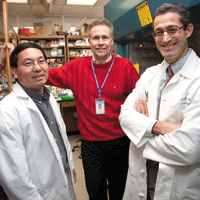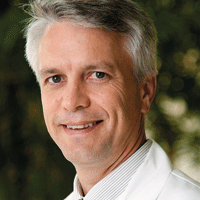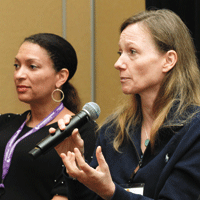Employees in the 21st century know this: To keep their jobs, they have to juggle multiple roles and projects. That’s true for hematologists as well. Not only must they have bedside manners, but they also have to maintain benchside research studies in the laboratory. With shrinking research dollars from the federal government, the magnetic pull toward the bright lights of oncology and a number of older hematologists retiring, patients could potentially face a shortage of trained bleeding disorders providers in the future.
That is, if it weren’t for the National Hemophilia Foundation’s (NHF’s) ongoing commitment to train and sustain clinician-researchers. “We continue to provide the NHF-Baxter Clinical Fellowship Program, making sure those hematologists we fund and who stay in the field stay connected to NHF,” says Neil Frick, MS, NHF’s vice president for research and medical information. “The more we can keep funding, the better.”
NHF provides other awards and fellowships at different points in healthcare providers’ careers. Familiarizing yourself with these research programs will help you see how NHF is dynamically involved at the bedside, bench and beyond (See sidebar, “NHF Research by the Numbers.”)
NHF-Baxter clinical fellowships
Since 2003, 29 people have been awarded the NHF-Baxter Clinical Fellowships to train with mentors at 22 hemophilia treatment centers (HTCs) across the country. The fellowship comes at a pivotal time in a physician’s decision to specialize in a particular field of medicine, during the 2nd–3rd year fellowship. It can entice MDs who have an interest in patients with bleeding disorders. “Once they get hooked into research, they’re often pretty motivated to follow that trajectory and to say, ‘I’ve found my academic niche,’” says Paul E. Monahan, MD, attending physician, Comprehensive Hemophilia Diagnostic and Treatment Center at the University of North Carolina at Chapel Hill. He chairs NHF’s research review committee.

Paul E. Monahan, MD (far right)
“The hope is that at the end of their two-year NHF-Baxter Clinical Fellowship, that they will get a subspecialty of hemophilia care within their specialty of hematology/oncology,” Frick says.
That’s the path taken by the two mentees of Steven W. Pipe, MD, chair of NHF’s Medical and Scientific Advisory Council (MASAC). He is also pediatric medical director of the Hemophilia and Coagulation Disorders Program and director of the Special Coagulation Laboratory at the University of Michigan (U-M) in Ann Arbor. Courtney Thornburg, MD, MS, received the fellowship from 2003–2005. “She gleaned all of her initial clinical skills in managing bleeding and clotting disorders here at our center,” Pipe says. Thornburg is now the medical director of the Hemophilia and Thrombosis Center at Rady Children’s Hospital-San Diego. She also co-directs the Hemostasis and Thrombosis Research Program.
The fellowship funded Pipe’s second mentee, Jordan A. Shavit, MD, from 2006 to 2008. Shavit’s focus then and now is on basic science research. This type of research helps answer such questions as: How do you test for a disease? What other bypassing agents could treat an inhibitor? “You need those basic science answers first so you can better support a treatment in the end,” says Frick.
Shavit now holds the position of assistant professor in the Department of Pediatrics and Communicable Diseases at U-M. “He recently got an RO1 grant from the National Institutes of Health (NIH) for his work on the zebrafish models for bleeding and clotting disorders,” says Pipe. Securing such a grant from the National Heart, Lung, and Blood Institute (NHLBI), the institute within NIH that supports bleeding disorders research, is the goal.
NHF’s vision for the training grant is now being fulfilled, says Pipe. The fellowship draws young investigators to the field, supports and trains them, and then watches them pass the baton. Nearly half of the past NHF-Baxter Clinical Fellowship award recipients whose researcher profiles are featured on hemaware.org are directing HTCs. Others are pediatric or adult hematologists. All are still conducting research. “This fellowship has allowed them to excel in their positions and become the leaders for the next generation,” Pipe says.
Judith Graham Pool Postdoctoral Research Fellowship Program
The Judith Graham Pool (JGP) Postdoctoral Research Fellowship is named for the researcher who discovered cryoprecipitate, a method of freezing and thawing human plasma to extract its rich supply of factor VIII (FVIII). Since 1972, 82 individuals have received the fellowship. “It falls prior to getting a faculty position at an institution, during the fellows stage, where candidates may not be solidified in their careers yet,” Frick says.
With JGP funding from 1998–2000, Monahan found the justification he needed to break away from the pressing demands of pediatric oncology and engage in bleeding disorders research. “I could tell my chairman, ‘I’ll see patients, but I need to have dedicated time for discovery,’” he says. Under the guidance of R. Jude Samulski, PhD, a noted virologist and early pioneer of gene therapy, Monahan pursued his project, “AAV Hemophilia Gene Therapy Vectors.”

Steven W. Pipe, MD
Other JGP awardees have contributed to the development of better factor concentrates and more accurate testing of carriers. They have improved understanding of the genetics of bleeding disorders and of how platelets function. “The list of awardees since 1972 reads like a Who’s Who of people who’ve had major impacts on hemostasis and thrombosis research,” Pipe adds.
Career Development Awards
Candidates for the Career Development Award (CDA) must apply within six years of obtaining a faculty position. Since 2000, 24 awards have been granted. “The grant helps them build up their research projects to the point where they have some outcomes,” Frick says. “It’s advanced research, where they could be testing ideas on animal models.” The CDA is funded by Novo Nordisk.
In 2000, Pipe’s CDA helped him transition from his mentor’s lab to his own lab. During the next three years he worked on novel genetically engineered FVIII molecules. “That was a productive time for me to establish the preliminary data,” he says. And it helped him obtain a five-year NHLBI grant. The CDA is a stepping stone to getting these types of government grants, Frick says.
Multipurpose mentors
The Baxter-Clinical Fellowships and JGP awards come with a built-in accountability factor—a mentor. On the clinical side, the mentor exemplifies an inspirational model of how to interact with patients, diagnose and treat them, says Monahan. On the research side, mentors guide mentees into new ways of thinking. “They provide the ability to ask a question, and figure out how to look at a hypothesis and see if it’s testable,” he says. “Mentors serve a lot of purposes.”
NHF’s Excellence Fellowships
NHF sponsors three fellowships for healthcare providers at HTCs: the Nursing Excellence Fellowship, the Physical Therapy Excellence Fellowship and the Social Work Excellence Fellowship. The fellowships help HTC staff carve out time for research. “It’s important for them to have that extra funding to dedicate time to research, which benefits the patient as well as the whole community,” Frick says.
The proof of those benefits is in the fellowship results. A nursing fellow’s project on emergency medical identification led to the creation of a recommendation from MASAC, which sets standards of care. Social workers have examined how women cope with bleeding disorders and the effects of depression. Physical therapists have analyzed assistive devices to aid patients with joint disease.
Research partners
NHF also promotes research by collaborating with other agencies to collect vital data on people with bleeding disorders. The My Life, Our Future initiative, a partnership between NHF, the American Thrombosis and Hemostasis Network (ATHN), Biogen and Bloodworks Northwest (formerly the Puget Sound Blood Center), offers genotyping through local HTCs. Since its launch in 2013, it has found 120 new mutations in patients with hemophilia A and B. Once 5,000 patients have contributed their de-identified information, expected sometime in 2015, data will be made available to researchers who apply for it. “As opportunities for research repositories, such as through MLOF and ATHN, grow, the hope is that research grows as well,” Frick says.
Every two years, NHF hosts the Workshop on Novel Technologies and Gene Transfer for Hemophilia, an international gathering of researchers. By sharing their findings, these colleagues contribute toward the goal of developing better treatments for bleeding disorders. “NHF is critical because it remains engaged at the cutting edge of where the research is,” Pipe says. He’s on the planning and steering committee for the workshops.
Show me the money
If you’ve supported one of NHF’s Hemophilia Walks or donated to the capital campaign “It’s Time for a Cure,” then you’ve funded research. NHF embraces not only the deep pocket funding from philanthropists and pharmaceutical companies, but also from individuals and families.
The bleeding disorders community values research and shows it. “This is where their voices are heard,” says Frick. For instance, the Cirelli family of East Hanover, New Jersey, organizes a yearly walk, donating all proceeds to a research fund honoring their son who has hemophilia: the Nicholas Cirelli Family Research Fund/NHF Judith Graham Pool Research Fellowship. Your donations are making a difference. “We’re funding two extra JGP fellowships this year, based on the fact that we’re getting more money from the public and chapters,” Frick says. (See sidebar, “Chapters Chip In.”) There is no industry funding for this fellowship.
Although prophylactic infusion of clotting factors has dramatically improved patients’ quality of life, the community didn’t stay complacent. “They said, ‘We’re going to have the greater dream of a genetic cure for hemophilia,’ ” says Monahan. “NHF and community members pushed NIH to make gene therapy a research priority.”
The recent realization of gene therapy trials on patients came to fruition through the cumulative findings of many investigators, all of whom supplied different clues. When Monahan drew up a table of the JGP and CDA award recipients whose research laid the groundwork for these trials, he saw a continuum. “You can draw a line from the research topics to the goal in this one example of gene therapy,” he says.
Now there are several gene therapy trials underway in humans. One, a partnership between University College London and St. Jude Children’s Research Hospital in Memphis, has data showing correction of factor IX for several years now. Some of the men with severe hemophilia no longer infuse factor product.
But bleeding disorders research goes beyond the needs of this community. “It has led to techniques and understanding of pathophysiology (disease-related functional changes) that is applicable to other diseases as well,” Monahan says. “The successes in hemophilia research pay for themselves several fold.”
Researchers give back

(Right) Rebecca Kruse-Jarres, MD, MPH
Lest you think that researchers robotically race from patient to lab and back, understand that they also volunteer. Leslie Raffini, MD, medical director of the Comprehensive Hemostasis and Thrombosis Center at The Children’s Hospital of Philadelphia, was one of the first NHF-Baxter Clinical Fellows in 2003. She now serves on MASAC. Michael Callahan, MD, assistant professor of pediatrics at Children’s Hospital of Michigan in Detroit, was an NHF-Baxter Clinical Fellow in 2006. In May 2015, he presented a Medscape Education Activity for hematologists. Rebecca Kruse-Jarres, MD, MPH, received an NHF-Baxter Clinical Fellowship in 2004. This year she co-chairs NHF’s Inhibitor Education Summits. She is assistant professor of medicine, Division of Hematology, at the University of Washington School of Medicine in Seattle. She is also director of the Hemophilia Care Program at Bloodworks Northwest. “If we keep them engaged with our population, hopefully it will keep them engaged forever,” concludes Frick.

